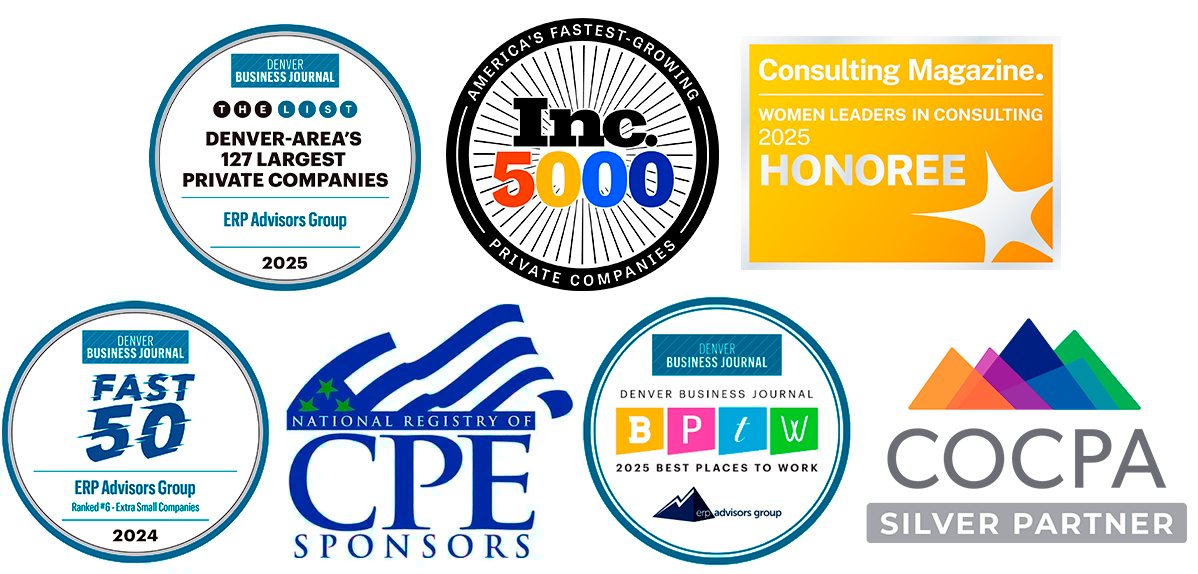
Not sure what to do about your outdated ERP? Your vendor may be pushing you to move to a newer product or the latest cloud version as your legacy software marches towards end of life. However, should you be skeptical of the supposed ease and benefits of moving to your existing vendor’s new product?
You don’t have to face this dilemma alone! On this episode of The ERP Advisor, we divulge how the specialists at ERP Advisors Group help our clients answer the age-old question: should I upgrade or replace my ERP?
Should You Upgrade Your Software or Move to a Different ERP Platform?
Not sure what to do about your outdated ERP? Your vendor may be pushing you to move to a newer product or the latest cloud version as your legacy software marches towards end of life. However, should you be skeptical of the supposed ease and benefits of moving to your existing vendor’s new product?
You don’t have to face this dilemma alone! On this episode of The ERP Advisor, we divulge how the specialists at ERP Advisors Group help our clients answer the age-old question: should I upgrade or replace my ERP?
Update vs Upgrade vs Overhaul: What’s the Difference?
The terms “update,” “upgrade,” and “overhaul” are often used interchangeably, but each of them has different meanings in the world of ERP. For the sake of this article, we will use the following definitions:
- Update: An update is when your solution receives normal patches or hotfixes. This typically does not change the foundation or functionality offered in your system. Most cloud solutions perform updates automatically, unlike on-premises applications that need to be manually “fixed.”
- Upgrade: Upgrades involve going to a slightly different, more recent version of your current product. This can include major new version launches or smaller annual releases that provide significant changes. Vendors may market a migration to the cloud version of their legacy application as “upgrades” but this often is not the case. On-premises and the cloud vary so vastly, these efforts tend to fall under our definition of overhaul.
- Overhaul: An overhaul refers to a complete migration to a “different” software solution, that involves software reconfiguration, a reimplementation, and/or a whole new implementation.
Take Microsoft Great Plains, for example. With recent announcements regarding the product’s end of life, confusion has clouded the paths forward. An update for Great Plains could be installing a hotfix or security patch provided by the vendor. An upgrade would be moving to a newer version of Great Plains (i.e., Microsoft GP 2018 to 2018 R2 or Microsoft GP 2015 R2 to GP 2018 R2). An overhaul, alternatively, would involve migrating off Great Plains onto a new product (or migrating from Microsoft Great Plains to Business Central).
Moving from Great Plains to Business Central might be casually referred to as an “upgrade,” but really it is a different product and requires a whole new implementation, so we consider it an overhaul. For more on the paths available to Great Plains customers and how they stack up against each other, check out our free guide.
Why Even Consider an Overhaul?
Overhauls are typically more complicated and involved than the prescribed upgrade paths offered by vendors. So why would you choose to overhaul your system rather than just upgrade it?
There are three main reasons why companies opt for an overhaul:
- Upgrades are rarely as simple as the vendor makes them seem. Complications will, unfortunately, always arise during the process, and if you are going to go through the pain and financial investment of upgrading, you may as well consider a potential change and how other solutions can benefit your business. Additionally, the recommended upgrade path may also be a completely different product , leading to a different set of complications during the implementation.
- Your product may be going away entirely. To stick with our earlier example, Microsoft has announced looming end-of-life dates for all versions of Great Plains. And because Business Central is a different product, it may not fit your business’s needs and will require a new implementation anyways. So, in that case, it is simply common sense to evaluate other vendors and products, as well.
- Your business has likely changed since you implemented your legacy solution, maybe 10, 20, or even 30+ year ago. You may have previously filled functionality gaps with customizations and workflows, or tedious manual processes that have barred you from receiving normal updates or upgrades. Newer platforms now have functionality built in to meet complicated needs out-of-the-box, without having to compromise future upgrades. This is just one examples of how an overhaul can save your team time and effort in the long term.
While we understand the desire to pick what seems to be the “easiest” path forward, that path may only stall the inevitable. You might want to simply rip the band-aid off now.
Why Aren’t Upgrades as Straightforward as they seem?
As mentioned previously, upgrades are rarely as easy as advertised. They can sometimes equate to a partial or full reimplementation. Only “cookie-cutter” implementations or migrations are easy, and very few implementations fall into the “cookie-cutter” category. No one has ever implemented or “upgraded” your instance of your software with your exact business structure and your data. As a result, the implementation will be entirely unique and is bound to encounter some roadblocks.
If your system is an older legacy platform, you likely had to develop a plethora of customizations to meet your business’s needs. Upgrades usually break customizations, which requires costly support to resolve issues and reconfigure the system, especially if the system is on-prem. Many businesses fall behind because they want to preserve their customizations and avoid more work to fill cracks caused by an upgrade. And if the proposed upgrade is on-premises to the cloud, it will look even more like a re-implementation or complete reconfiguration, on top of other needs like training and data. The further behind on versions you are, the more you will need to invest in getting your system to a place of support.
Updates and Upgrades On-Prem vs In the Cloud
Updates and upgrades are typically far more complex and involved on-premises than in the cloud. On-prem updates and upgrades are not required by the vendor, making it easy to fall behind. This often means missed security patches and functionality updates unless a technical resource on the team has time to manually make upgrades and test those changes for broken code or other issues. This requires significant attention from the support team to execute. However, technical resources for on-prem systems are beginning to become more and more sparse as technology evolves, which could leave your system stranded without support.
Solutions in the cloud, however, receive automatic updates during scheduled “downtimes” and teams have access to sandboxes where updates can be tested before being deployed. Cloud-based systems also offer easier access to support and technical resources for testing updates and upgrades, simplifying the process of identifying and quickly fixing issues caused. As mentioned above, some vendors even utilize Artificial Intelligence to detect system anomalies and alert technical staff.
If you’re looking to migrate your on-prem product to the cloud, there may not be a direct path from your current version. Sometimes the vendor can only support an upgrade from Version X to the cloud, not Versions Y or Z, so you must upgrade to at least X as a stopgap before moving to the cloud. This essentially equates to two different projects, each with designated resources. All that work considered, we are back to our original question:
Should We Upgrade or Overhaul?
As is the case with most complex ERP projects, it is important to first understand your needs before jumping into the decision-making process. Consider what functionality you need presently and what you will need as your business grows. Make sure to also document any current pain points to ensure they are addressed during the selection.
The next step would be to make sure you understand your current product’s support cycle. Is your software going to be reaching end of life or end of support soon? If so, you will need to consider your options sooner rather than later. By knowing your product’s roadmap, you can better understand your timeline.
From there, you can evaluate what is on the market! If you have to undergo a complex ERP upgrade anyways, you may as well do your due diligence and evaluate if there are options on the market that could better fit your needs. The only way you can make a truly informed decision is if you know all your options.
Finally, reach out to an advisor! Many have never confronted an ERP implementation, while an unlucky few have encountered it more than once (although this is rare). Advisors (like ERP Advisors Group) lead ERP implementations every day and can help you determine which path makes the most sense for your business and its needs.
Conclusion
There are benefits to following your vendor’s recommended upgrade pathway. But how easy will that process actually be and is the vendor’s latest product be the best option for your evolving business needs? These questions must be considered when weighing an upgrade against an overhaul, because both will likely involve complex implementation processes you cannot afford to mess up. If you are unsure how to proceed with your own ERP project, our team can help. Schedule your free consultation today to speak with the experts at ERP Advisors Group.







